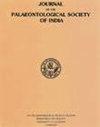High-resolution calcareous nannofossil biostratigraphy and facies of Nimar Sandstone Formation (Bagh Group), central India and its bearing on Oceanic Anoxic Event 2
IF 0.6
4区 地球科学
Q4 PALEONTOLOGY
Journal of the Palaeontological Society of India
Pub Date : 2023-06-01
DOI:10.1177/05529360231200513
引用次数: 0
Abstract
It is proposed to consider Narmada Valley Late Cretaceous sequences in three sectors with proper selection of stratotype in each sector: Eastern Sector: comprising of Lameta group of rocks with type area in Jabalpur area, essentially laid down in lacustrine-paedogenic milieu and containing a variety of fossils including dinosaur remains of Late Maastrichtian age. No evidence of sea incursion is available in the Eastern Sector either via the Narmada lineament or the K-G Basin. Central Sector: comprising of the Bagh Group in ascending order of: Nimar Sandstone Formation–Nodular Limestone Formation–Coralline-Bryozoan Limestone Formation, laid down in estuarine complex entirely within Turonian without any evidence of Cenomanian and Coniacian age calcareous nannofossils or other fossils being present. In the western part of Central Sector: Siliciclastic rocks and limestones referred to as Nimar Sandstone Formation curiously lack Late Cenomanian marker species, hence could be of Early Turonian age. Western Sector: comprises of Lacustrine sediments associated with Deccan Flood Basalt. The absence of the Cenomanian/Turonian Boundary and Black shales negates the presence of global OAE2 events in the Narmada lineament, but several OAE events are recognised in the Cauvery Basin, southeastern India. Uranium- and Thorium-rich Lower and Upper Nimar Sandstone Formation overlying crystalline basement are interpreted to have been essentially laid down in a fully marine estuarine milieu with reworked plant, and palynofossils including dinosaur remains. Calcareous nannofossils recovered from Upper Nimar Sandstone Formation over four decades ago and assigned Late Turonian age is revised based on modern data incorporating calcareous nannofossil and planktonic foraminifera datum and now suggest an older age of Early Turonian matching a zone with FAD of Quadrum gartneri at the base and FAD of H. helvetica at the top. It must be emphasised that except for the solitary and unique incursion of Early Turonian (ca. 93.9 Ma) sea along the Narmada lineament reaching eastward (>300 km) up to the present town of Indore, no other marine intrusion ever took place on Indian shield except along collision facing Subathu–Dogadda lineament during Late Maastrichtian. It would be erroneous to suggest that the global eustatic rise of sea level caused the entry of the Turonian sea along the Narmada lineament; instead, it was earlier speculated by me that Large Igneous Province activity of Mahajanga Flood Basalt of Madagascar (ca. 93.9 Ma) could have most probably caused a short-lived Turonian sea to enter Narmada lineament from the west around C/T boundary.印度中部巴格群Nimar砂岩组高分辨率钙质纳米化石生物地层与相及其与海洋缺氧事件2的关系
建议将Narmada Valley晚白垩世层序划分为3个扇区,每个扇区选择合适的层型:东部扇区由Jabalpur地区的Lameta组岩石组成,具有类型区,主要发育于湖生—成幼环境,含有多种化石,包括晚马斯垂克时代的恐龙遗迹。在东部地区,无论是通过纳尔马达线还是K-G盆地,都没有海上入侵的证据。中段:由巴格群组成,按顺序依次为:尼马尔砂岩组-结节灰岩组-珊瑚-苔藓虫灰岩组,完全位于Turonian的河口杂岩中,没有任何证据表明Cenomanian和Coniacian时代的钙质纳米化石或其他化石存在。在中部西部:被称为Nimar砂岩组的硅屑岩和灰岩奇怪地缺乏晚塞诺曼尼亚标志物种,因此可能是早Turonian时代。西部:包括与德干洪水玄武岩相关的湖相沉积物。Cenomanian/Turonian Boundary和Black页岩的缺失否定了Narmada剖面中全球OAE2事件的存在,但在印度东南部的Cauvery盆地中发现了一些OAE事件。富铀和富钍的上下Nimar砂岩组覆在结晶基底上,被解释为基本上是在一个完全海相的河口环境中沉积的,其中有经过改造的植物和孢粉化石,包括恐龙遗骸。根据钙质纳米化石和浮游有孔虫的现代资料,对40多年前从上尼玛尔砂岩组中发现的钙质纳米化石进行了修订,确定了晚Turonian的年龄,现在认为早Turonian的年龄更大,与底部的Quadrum gartneri和顶部的H. helvetica的FAD相匹配。必须强调的是,除了早期Turonian(约93.9 Ma)的海洋沿着Narmada线向东(>300公里)直到现在的Indore镇的单独和独特的入侵外,除了在马斯赫特晚期沿着面对Subathu-Dogadda线的碰撞,没有其他海洋入侵发生在印度盾上。认为全球海平面的上升引起了土耳其海沿纳尔马达线的进入是错误的;相反,我早些时候推测,马达加斯加Mahajanga洪水玄武岩(约93.9 Ma)的大火成岩省活动很可能导致短暂的Turonian海在C/T边界附近从西部进入Narmada线条。
本文章由计算机程序翻译,如有差异,请以英文原文为准。
求助全文
约1分钟内获得全文
求助全文
来源期刊

Journal of the Palaeontological Society of India
PALEONTOLOGY-
CiteScore
1.10
自引率
16.70%
发文量
0
期刊介绍:
The journal is devoted to the publication of original papers and review articles dealing with all aspects of Paleontology, Paleobotany, Stratigraphy, Geochronology, Anthropology and Pre-history.
 求助内容:
求助内容: 应助结果提醒方式:
应助结果提醒方式:


